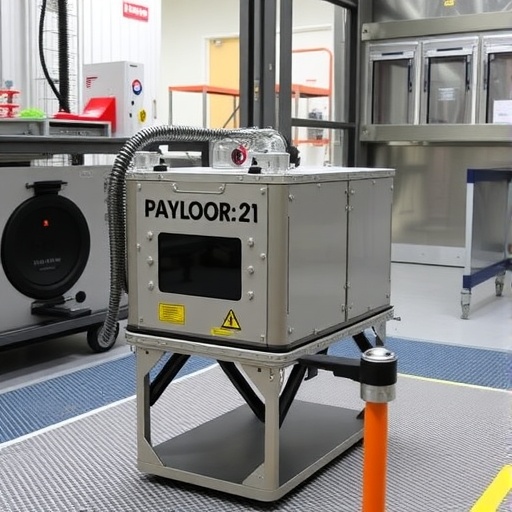The U.S. Naval Research Laboratory (NRL) has recently achieved a pivotal milestone in the realm of satellite servicing technology, heralded by the successful completion of critical space-readiness testing for its innovative robotic spacecraft. This landmark development is fueled by collaborative efforts alongside the Defense Advanced Research Projects Agency (DARPA) and Northrop Grumman’s SpaceLogistics. On September 5, 2025, NRL conducted a rigorous thermal vacuum (TVAC) test aimed at pushing the boundaries of what’s possible in orbiting satellite maintenance and upgrades.
The TVAC testing regime confirmed that the Robotic Servicing of Geosynchronous Satellites (RSGS) payload, integrated with the Northrop Grumman Mission Robotic Vehicle (MRV) spacecraft bus, can withstand the extreme conditions found in the vacuum of space, encompassing severe temperatures that fluctuate dramatically. Successfully managing these harsh environments not only underscores the payload’s durability and functionality but sets a promising precedent for future satellite operations. The completed tests are a significant step toward the RSGS’s eventual deployment, ultimately aimed at reshaping our approach to satellite maintenance.
The innovative RSGS program emerges from over two decades of rigorous research and development at NRL. It signifies a long-term vision to create advanced robotic systems capable of extending the operational life of satellites in geosynchronous orbit, which sits approximately 22,000 miles above Earth’s surface. The partnership with DARPA and Northrop Grumman’s SpaceLogistics has led to significant advancements in robotic servicing capabilities, enabling a wide range of applications from inspections and adjustments to repairs of satellites already in orbit.
Dr. Bruce Danly, the NRL director of research, described the completion of the spacecraft’s thermal vacuum testing as a monumental milestone affirming that the NRL-developed payload works effectively with MRV as a unified system. This breakthrough opens pathways to extend satellite lifetimes and reduce operational costs, all while enabling new mission profiles that were previously unattainable. As the landscape of satellite operations continues to evolve, such developments are crucial to maintaining strategic advantages in space.
Traditionally, satellites are built with redundant systems intended to act as backups, primarily because they could not be modified or repaired post-launch. The RSGS paradigm reshapes this narrative, offering a viable solution that could fundamentally alter how we conceptualize satellite operations in geostationary orbit. The potential for in-orbit repairs and upgrades introduces significant efficiencies, allowing satellites to be rejuvenated rather than replaced, reducing waste and environmental impact.
Jim Barnds, NRL RSGS program manager, emphasized that the program’s triumph goes beyond mere technological achievements; it also embodies the culmination of exceptional teamwork. NRL has not only engineered the robotic payload and various components but has also spearheaded mission designs, flight operations, and simulations necessary for making robotic servicing viable for both governmental and commercial endeavors. It reflects a new ethos in space operations characterized by collaboration and innovation.
The RSGS payload has been meticulously engineered with the U.S. Department of Defense’s reliability standards in mind, featuring redundant robotic arms and sophisticated avionics. Its comprehensive design includes a Rendezvous and Proximity Operations suite enriched with an array of sensors, multiple cameras, and infrared imaging capabilities. These advanced tools facilitate secure approaches to client satellites, ensuring safety and precision during servicing tasks. The two robotic arms included in the design come equipped with various tools capable of performing complex tasks, such as inspections and upgrades, while also allowing for the addition of new tools after the satellite’s launch.
The completion of the thermal vacuum testing at NRL serves as a prelude to further integration tests planned for the fall at Northrop Grumman’s facility in Dulles, Virginia. This next phase will confirm that all systems operate seamlessly together as a cohesive unit. After completing these final evaluations, the spacecraft will transition to launch preparations, an exciting step that amplifies anticipation for its orbital debut.
Once the robotic payload and MRV are in space, the system will embark on a series of rigorous checkout processes. These operations will involve proximity operations and demonstrations of client servicing tasks, ranging from resolving anomalies and modifying orbits to performing vital upgrades and inspections. This suite of capabilities promises to extend the operational life of active satellites and significantly enhance their functionality.
The RSGS mission is rightly poised to showcase its robotic capabilities in orbit for the first time, potentially marking the onset of a new era for resilient, sustainable space operations. With advancements in technology and innovative approaches to satellite repair and servicing, the capabilities offered by RSGS could redefine existing paradigms related to satellite life management.
As the preparation for the mission gains momentum, the implications stretch far beyond just improved satellite functionality. It hints at broader applications in space exploration, where the potential for repairing and upgrading machinery in orbit could become a standard practice. This transformative technology can lead to more sustainable use of resources and greater economic efficiencies in space endeavors.
In conclusion, the progress made by the NRL and its partners not only illustrates the power of collaboration but also highlights a crucial shift in how we approach satellite operations in an ever-evolving space domain. As preparations for launch continue, stakeholders in the commercial and governmental sectors alike will keenly observe the unfolding developments that RSGS promises to bring.
Subject of Research: Robotic satellite servicing technology
Article Title: U.S. Naval Research Laboratory Achieves Major Milestone in Robotic Satellite Servicing
News Publication Date: October 2023
Web References: N/A
References: N/A
Image Credits: U.S. Navy photo by Sarah Peterson
Keywords
Space sciences, Space technology, Space research




